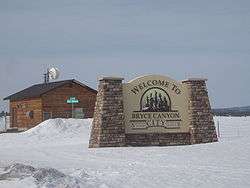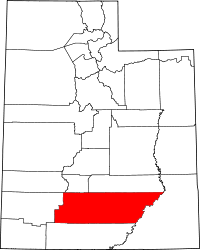Bryce Canyon City, Utah
| Bryce Canyon City | |
|---|---|
| Town | |
|
Bryce Canyon City welcome sign (in early spring) | |
 Location in Garfield County and state of Utah. | |
| Coordinates: 37°40′26″N 112°09′25″W / 37.67389°N 112.15694°WCoordinates: 37°40′26″N 112°09′25″W / 37.67389°N 112.15694°W | |
| Country | United States |
| State | Utah |
| County | Garfield |
| Founded | 1916 |
| Incorporated | July 23, 2007 |
| Founded by | Reuben C. "Ruby" Syrett |
| Named for | Bryce Canyon |
| Government | |
| • Type | Mayor-council government |
| • Mayor | Rod Syrett |
| Area[1] | |
| • Total | 3.5 sq mi (9 km2) |
| • Land | 3.5 sq mi (9 km2) |
| • Water | 0 sq mi (0 km2) |
| Elevation[2] | 7,664 ft (2,336 m) |
| Population (2010) | |
| • Total | 198 |
| • Density | 57/sq mi (22/km2) |
| Time zone | Mountain (MST) (UTC-7) |
| • Summer (DST) | MDT (UTC-6) |
| ZIP code | 84764 |
| Area code(s) | 435 |
| GNIS feature ID | 2371469[2] |
Bryce Canyon City is a town in Garfield County, Utah, United States, adjacent to Bryce Canyon National Park. The town, formerly known as Ruby's Inn, was officially incorporated on July 23, 2007 under a controversial, short-lived state law. The population was 198 at the 2010 census.
Geography
Bryce Canyon City is located some 20 miles (32 km) east of Panguitch, just outside the park entrance at the northwest corner of Bryce Canyon National Park, about 2.5 miles (4.0 km) north of the park's visitor center. The town lies alongside Utah State Route 12, near the park's popular Sunset Point.[3]
History
Reuben C. "Ruby" Syrett built a lodge and cabins at this location in 1916, when the promotion of Bryce Canyon for tourism was just beginning. Syrett's business grew along with the park's popularity, particularly once it was made a National Park in 1928. Ruby's Inn became an important junction; its travelers' services developed into a small community.[3] Syrett donated land to the state for construction of a road (now Utah State Route 63), strategically placing Ruby's Inn right at the entrance to the park.[4]
In 2007, the Utah State Legislature unanimously passed H.B. 466, a bill that amended the state law on petitions to incorporate a town. The new provisions allowed a petition for a new town with 100–999 residents to be filed with just the signatures of the owners of a majority of the land area,[5] even a single majority landowner.[6] If the petition met the conditions of state law and its signers owned the majority of the land by value, the new law required the county government to grant the petition and appoint a mayor and town council from a list of individuals approved by the petitioners.[5]
The Syrett family, owners of Ruby's Inn, had been seeking municipal incorporation for some time, hoping to qualify for a portion of county sales tax revenue to help fund the water system and other community infrastructure. They jumped at the opportunity to incorporate under the new law, filing a new petition soon after its passage. Garfield County officials had repeatedly denied the request for a new town, unwilling to give up some 10 percent of the county budget. County officials discovered, however, that they no longer had any option under the provisions of H.B. 466; the petition was in order, and they were required to grant it.[7] On July 23, 2007, Bryce Canyon City became the first town incorporated under the amended law. In fact, it was the only one before the legislature amended the law again in early 2008. Three other Utah towns that already had petitions pending, Hideout, Independence, and Powder Mountain,[8] were grandfathered in, but under the 2008 law there must be at least five petition sponsors, who were not allowed themselves to own more than 40 percent of the land. The new law also granted the county government more authority in the process, and required the town government to be elected.[9]
Demographics
| Historical population | |||
|---|---|---|---|
| Census | Pop. | %± | |
| 2010 | 198 | — | |
| Est. 2015 | 223 | [10] | 12.6% |
Bryce Canyon City is one of the few population centers in a sparsely populated, rural area. At incorporation, the officially estimated population was 138.[7] A majority of the residents are members of the Syrett family, and nearly all of the adults are employees of Ruby's Inn. The year-round population is only a fraction of the people who occupy the town at the peak of tourist season, when employment swells to 600, and the number of visitors is in the thousands, more than the total population of Garfield County.[4]
As of the census[12] of 2010, there were 198 people residing in the town. There were 118 housing units. The racial makeup of the town was 62.6% White, 0.5% Black or African American, 4.5% American Indian and Alaska Native, 18.7% Asian, 12.6% from some other race, and 1.0% from two or more races. Hispanic or Latino of any race were 24.2% of the population.
Government
Bryce Canyon City is a company town, consisting solely of the property of Ruby's Inn and the Syrett family, its third-generation owners. Rod Syrett, the company's board president, was chosen as the first mayor.[4]
References
- ↑ "2010 Census U.S. Gazetteer File for Places: Utah". Retrieved May 23, 2011.
- 1 2 U.S. Geological Survey Geographic Names Information System: Bryce Canyon City
- 1 2 Van Cott, John W. (1990). Utah Place Names. Salt Lake City, Utah: University of Utah Press. p. 323. ISBN 0-87480-345-4.
- 1 2 3 Stolz, Martin (July 24, 2007). "In Utah, a 'Company Town' Means Just That". The New York Times. Retrieved September 29, 2009.
- 1 2 "H.B. 466—Incorporation of a Town Amendments". Bills and Resolutions. Utah State Legislature. 2007. Retrieved September 29, 2009.
- ↑ Dougherty, Joseph M. (December 18, 2007). "Petition filed to create 3rd new city in Wasatch". Deseret News. Retrieved September 28, 2009.
- 1 2 Kinkead, Lucinda Dillon (September 30, 2007). "Ruby's dream? Creation of Bryce Canyon City elicits cheers and jeers". Deseret News. Retrieved September 29, 2009.
- ↑ "Background". Powder mountain Citizen's Rights Defense Group. 2008. Retrieved December 3, 2009.
- ↑ "H.B. 164—Town Incorporation Process Amendments". Bills and Resolutions. Utah State Legislature. 2008. Retrieved September 29, 2009.
- ↑ "Annual Estimates of the Resident Population for Incorporated Places: April 1, 2010 to July 1, 2015". Retrieved July 2, 2016.
- ↑ "Census of Population and Housing". Census.gov. Archived from the original on May 11, 2015. Retrieved June 4, 2015.
- ↑ "American FactFinder". United States Census Bureau. Retrieved July 20, 2012.
External links
 |
Panguitch | Circleville, Kingston, Antimony | Escalante |  |
| Hatch | |
Tropic | ||
| ||||
| | ||||
| Bryce Canyon National Park |
Bryce Canyon National Park |
Cannonville |

